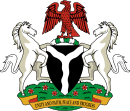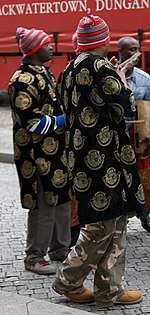Fashion in Nigeria

| This article is part of a series in |
| Culture of Nigeria |
|---|
 |
The fashion industry in Nigeria plays an important cultural role and contributes significantly to the country's economy. Clothing incorporates a variety of colours, fabrics, and embellishments (often beads). Many of the component cultures of Nigeria wear styles that are characteristic of their tribal society and customs. Nigeria produces fashionable textiles and finished garments and has designers who have achieved international recognition.
Traditional garments


Nigerians usually dress casually because of the hot climate. However, both formal and traditional clothing are also worn. Many African cultures have a characteristic traditional style of dress that is important to their heritage.[1] Traditional garments worn in Nigeria include:
The Yoruba men wear agbada, which is a formal attire, commonly worn as part of a three-piece set: an open-stitched full gown, a long-sleeved shirt, and sokoto (trousers fitted snugly at the ankle).[2]
The Hausa wear Babaringa. The isiagu is a men's pullover shirt similar to a dashiki that is worn by many groups in Africa. The traditional attire of Igbo men includes an isiagu patterned with embroidered lion heads, usually worn with trousers and a traditional striped hat.[2]
Traditional Yoruba dress uses fine beads and textiles to reflect social status and religious affiliation as well as personal identity and taste, Gold and other jewelry is also worn by Yoruba women.[3]
The Edo also traditionally express their status and identity with beads, but also with raffia work, anklets, and bangles. Edo men traditionally wear coral beads of two kinds, ekan and ivie, with either suits or traditional robes; traditionally, they wear a white shirt contrasting with brightly striped fabric.[2]
The gele is a traditional Yoruba woman's head wrapping made of firm material. It may be worn as a fashionable accessory on formal occasions but can also be a daily wear.[2] The gele is peered with Iro ati Buba, Komole dress or Asoebi dresses by Yoruba women. Edo women wear a wedding crown called an okuku.[2]
Muslim women in northern Nigeria wear various types of veil, including the hijab, which reveal the face but cover the hair and may cover much of the body. Veiling may take fashionable forms.[4]
Nigerian fashion
Euromonitor estimated in 2015 that Nigeria accounted for 15% of a $31 billion fashion market in Sub-Saharan Africa. The Nigerian fashion industry grew 17% between 2010 and 2019, with events such as Lagos Fashion Week helping to promote it.[5] The Covid-19 pandemic, which moved fashion shows online, led to more attention to Lagos Fashion Week and other fashion showcases in Africa.[6]
Nigerian fashion has been popularized by the Nigerian edition of the South African magazine Drum, which was launched in Lagos in 1958 and featured images of the "new" Nigerians.[7] In the late 20th century, several editions of the Dressense Fashion Catalogue were produced by fashion designers in Nigeria, aimed at the upscale market.[7] The Fashion Designers Association of Nigeria was established in 1989 by Kola Kuddus to promote Nigerian fashion both domestically and internationally,[8] and the Central Bank of Nigeria has an initiative to support fashion designers.[6]
Designers

Nigeria has produced many fashion designers.
Shade Thomas (later Thomas-Fahm) became Nigeria's first widely recognized fashion designer. After studying fashion design in England in the 1950s, prior to Nigerian independence, she set up a shop at the Federal Palace Hotel in Lagos and a garment factory at the Yaba Industrial Estate. Specializing in simple designs using locally woven and dyed textiles, she became locally and internationally known in the 1960s and 1970s.[7]
Fadipe Adedamola Olaniyi is CEO of Hoodies and Stones Clothing, which promotes African culture through its products.[9]
Duro Olowu is a Nigerian women's wear designer with Jamaican roots who launched his own label in the 2000s.[10]
Lisa Folawiyo uses traditional West African fabrics to produce modern tailored designs. She launched her label, Jewel by Lisa, in 2005e.[10] She also produces custom luxury prints and accessories, such as jewelry and purses. Line J Label, her diffusion line, showcases urban fashion with Afropop influences.[11]
Philip Ojire launched his urban fashion label Freak Vault Clothing, formerly Shirt Freak, in 2017.[12][13]
Omotoso Oluwabukunmi runs tWIF Clothing;[14] the name is an acronym of The Way It Fits. Launched in 2012, the company produces branded apparel for businesses and other organizations, as well as own-brand menswear including shirts, pants, suits, and native attire.[15][16]
Kenneth Ize, a menswear designer who grew up in Austria,[17] won the Fashion Focus prize and was one of the first Nigerian designers to have his clothes sold at Browns in London.[5]
Tolu Coker, a British designer, pays ha lote in her fashion designs to her Yoruban heritage from her parents.[6][18]
Evolution of Nigerian Fashion
The rich cultural diversity in Nigerian society has a huge influence on the Nigerian fashion world, with the various elements of the varying ethnic groups showcasing their unique designs and customs even in the modern-day world. Nigerian fashion goes beyond the display of beautiful designs to the portrayal of cultural and symbolic importance with the incorporation of some indigenous textiles such as the adire, aso oke, and ankara prints.[19] Although there have been a lot of changes in the Nigerian fashion world, there is still a retention of its unique beauty and originality. Fashion in the 1960s was characterized by women dressing in both fitted and oversized attires as well as mini skirts and dresses with simple local hairstyles and Afros. While the men wore bright-coloured shirts in different patterns and marched with tight skinny pants. The 1970s were characterized by baggy-sleeved buba worn on wrappers tied a little above the knees to the mid-thighs called Oleku for women, and men wore agbada and danshiki outfits with both gender jerry curls and permed hair. The 1980s had women wearing maxi skirts and men oversized suits with huge permed hair. The fashion trend started to experience a significant change in the 1990s with the influence of America with miniskirts and scousers and native boubous for women. Men also had a difference in the trouser fashion with narrower hems and loosely fitted around the hip and waist region.[20] Currently, Nigerian fashion continues to change and evolve with the incorporation of traditional fabrics and bold, colourful designs to make different styles. Nigerian streetwear has gained global recognition on the world of fashion stage, with the likes of Kenneth Ize[21] being chosen as one of the finalists for the LVMP Prize for emerging fashion designers.[22] Another prominent Nigerian designer is Amaka Osakwe, founder of the Maki Oh, whose design was worn by the then-first lady of the United States Michelle Obama.[23]
See also
References
- ^ Victoria, Rovine (2010). "Fashion in African Dress". Berg Publishers: 62–67 – via Berg Fashion Library.
- ^ a b c d e "Traditional Nigerian Clothing". WorldAtlas. Retrieved 2 December 2020.
- ^ Abiodun, Rowland (2010). "Yoruba in Nigeria and Diaspora". Berg Encyclopedia of World Dress and Fashion: Africa: 297–304 – via Bloomsbury Fashion Central.
- ^ Renne, Elisha (2010). "Hijab Fashions in Northern Nigeria". Berg Encyclopedia of World Dress and Fashion: Global Perspectives. Oxford: Berg. doi:10.2752/BEWDF/EDch10720. ISBN 9781847888594 – via Bloomsbury Fashion Central.
- ^ a b Akinsola, Wunmi (18 November 2022) [11 June 2019]. "The state of Nigeria's Fashion Industry". Stears. Retrieved 24 August 2023.
- ^ a b c Chibelushi, Wedaeli (2 March 2024). "How luxury African fashion has wowed Europe's catwalks". BBC News.
- ^ a b c Denzer, LaRay (2010). "The Nigerian Fashion Scene". Berg Encyclopedia of World Dress and Fashion. Vol. 6: West Africa. Oxford: Berg. pp. 331–336. doi:10.2752/BEWDF/EDch1050. ISBN 9781847888501 – via Bloomsbury Fashion Central.
- ^ "Fashion Designers Association of Nigeria". Haute Fashion Africa. Retrieved 2 December 2020.
- ^ "Five leading clothing brand that supports African culture". tribuneonline. 15 March 2021. Retrieved 21 June 2023.[dead link]
- ^ a b Gachanja, Nelly (6 April 2019). "10 Best Nigerian Fashion Designers". Africa.com. Retrieved 2 December 2020.
- ^ "Lisa Folawiyo". Haute Fashion Africa. Retrieved 2 December 2020.
- ^ "Top 5 Nigerian-based urban fashion brand". Guardian. Nigeria. 10 December 2021. Retrieved 24 August 2023.
- ^ "Mercy Johnson, Juliet Ibrahim, Iyabo Ojo leads Philip Ojire's Shirt freak 2021 summer shirt dress collections". New Telegraph. 1 June 2021. Retrieved 16 May 2023.
- ^ "Helping people look good makes me happy – Omotoso". Punch (interview). Nigeria. 19 July 2020. Retrieved 16 May 2023.
- ^ "Mike Edwards wins the 2020 AMVCA for best dressed wearing tWIF Clothing". tribuneonline. 1 June 2021. Retrieved 16 May 2023.
- ^ "Omotoso Oluwabukunmi's TWIF Clothing Line Wardrobe Davido's Musical Video". This Day. 1 May 2020. Retrieved 16 May 2023.
- ^ Diderich, Joelle (4 January 2023). "With His Label on Hiatus, Kenneth Ize Plots His Next Move". WWD. Retrieved 3 March 2024.
- ^ Benissan, Ezreen (18 September 2023). "Meet London designer Tolu Coker. NewGen's new star?". Vogue Business. Retrieved 3 March 2024.
- ^ Idoko, Nicholas (2023-08-26). "The Role of Culture in Nigerian Fashion Design Industry". Professions in Nigeria. Retrieved 2024-04-08.
- ^ Nigeria, Guardian (2021-10-03). "The Evolution Of Nigerian Fashion Since Independence". The Guardian Nigeria News - Nigeria and World News. Retrieved 2024-04-08.
- ^ Odu, Mazzi (2019-07-16). "Kenneth Ize, the LVMH-prize finalist redefining African luxury". CNN. Retrieved 2024-04-08.
- ^ "The History Of Nigerian Fashion". Naija Culture. 2023-04-30. Retrieved 2024-04-08.
- ^ Williams, Sean (2018-08-28). "The evolution of Nigerian fashion". Open Skies. Retrieved 2024-04-08.
External links
- Fashion Designers Association of Nigeria (archived on 8 August 2022)

